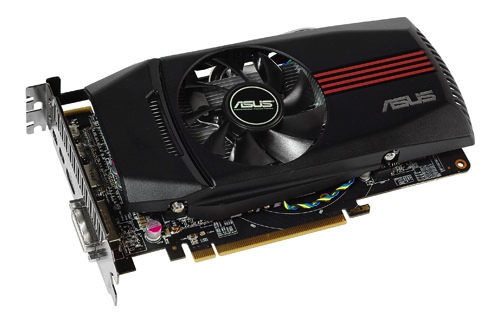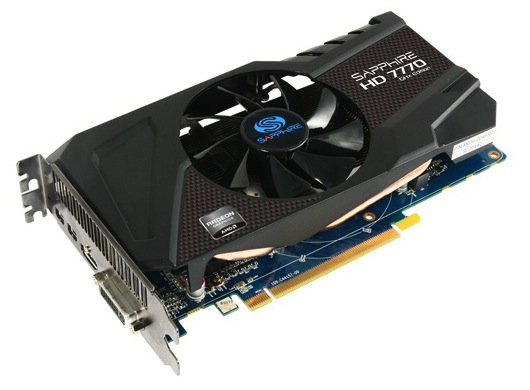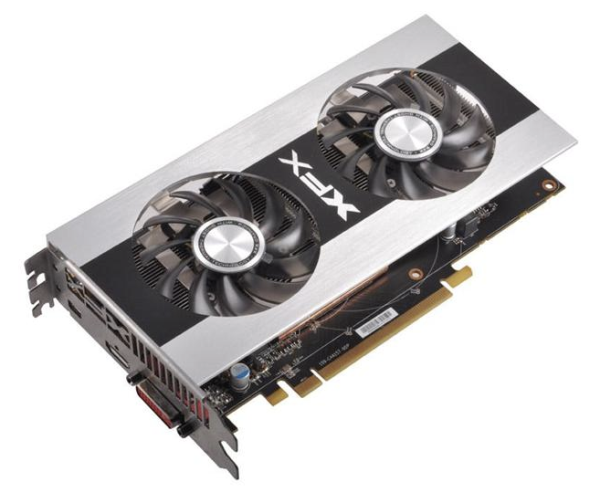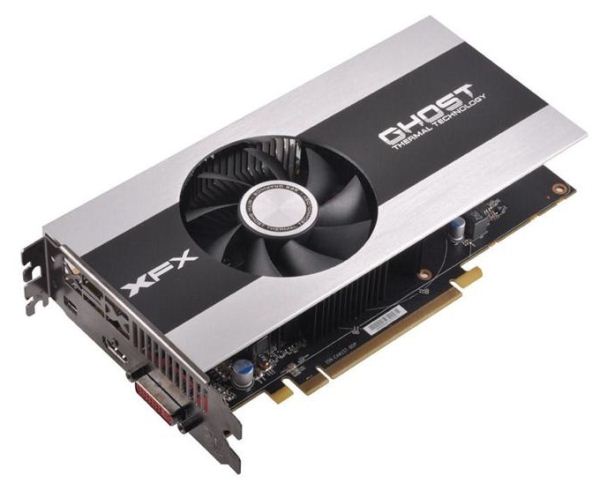AMD Radeon 7770 Launch Recap
by Andrew Cunningham on February 20, 2012 9:30 PM EST- Posted in
- AMD
- Radeon
- Radeon HD 7000
- GPUs
We got off pretty easily with our 7750 launch recap earlier today - with only three cards, it was pretty simple to compare and contrast them and be done with it. The 7770 represents the higher end of the mainstream, though, and as such AMD's partners appear to be pushing it into the channel a bit more aggressively. We've got ten cards to look at this evening, details about which you can find in the tables below.
Our 7750 and 7770 series review noted that these cards provided excellent performance per watt, each of which competes with (7750) and outperforms (7770) the old 5700 series while using significantly less power (remember, the 6700 series was just a rebrand of the 5700 cards). The downside comes in gaming performance for the price - the 7770 is generally outdone in performance by the 6850, which can currently either match it or beat it in price after rebates. That said, if you want decent performance and GCN features without shelling out for a pricier 7900-series card, the 7770 may be the card for you.
| ASUS | Gigabyte | MSI | PowerColor | Sapphire (GHz Edition) | |
| Part Number | HD7770-DC-1GD5 | GV-R777D5-1GD* |
R7770- |
AX7770 1GBD5-2DH | 11201-00-20G |
| Core Clock | 1020 MHz | 1000 MHz | 1020 MHz | 1000 MHz | 1000 MHz |
| Memory Clock (Effective) | 1150 MHz (4600 MHz) | 1125 MHz (4500 MHz) | 1125 MHz (4500 MHz) | 1125 MHz (4500 MHz) | 1125 MHz (4500 MHz) |
| Dimensions in inches (dimensions in mm) | 8.9 x 5.5 x 1.6 (226.06 x 137.9 x 40.64) | 8.35 x 5.37 x 1.63 (212 x 136.5 x 41.5) | 9.25 x 4.37 x 1.50 (235 x 111 x 38) | 8.27 x 4.49 x 1.50 (210 x 114 x 38) | 8.27 x 4.33 x 1.69 (210 x 110 x 43) |
| Outputs | 2x Mini DisplayPort, HDMI, DVI-I | 2x Mini DisplayPort, HDMI, DVI-I | 2x Mini DisplayPort, HDMI, DVI-I | 2x Mini DisplayPort, HDMI, DVI-I | 2x Mini DisplayPort, HDMI, DVI-I |
| Included accessories | DVI to VGA adapter, CrossFire bridge | N/A** | DVI to VGA, CrossFire bridge, Mini DisplayPort to DisplayPort, 4-pin to 6-pin power adapter* | DVI to VGA, Mini DisplayPort to DisplayPort | DVI to VGA adapter, Mini DisplayPort to Display Port, 4-pinto 6-pin power adapter |
| Warranty | 3-year | 3-year | 3-year parts/2-year labor | 2-year | 2-year |
| Price (Newegg) | $159.99 | $159.99 | $159.99 | $159.99 | $159.99 |
|
Sapphire (OC Edition) |
Sapphire (OC Edition) | XFX (Core Edition) | XFX (Double D Edition) | XFX (Double D Black Edition) | |
| Part Number | 11201-00-20G | 11201-02-40G | FX-777A-ZNF4 | FX-777A-ZDF4 | FX-777A-ZDB4 |
| Core Clock | 1150 MHz | 1150 MHz | 1000 MHz | 1000 MHz | 1095 MHz |
| Memory Clock (Effective) | 1250 MHz (5000 MHz) | 1250 MHz (5000 MHz) | 1125 MHz (4500 MHz) | 1125 MHz (4500 MHz) | 1245 MHz (4980 MHz) |
| Dimensions in inches (dimensions in mm) | 8.27 x 4.33 x 1.69 (210 x 110 x 43) | 8.27 x 4.33 x 1.69 (210 x 110 x 43) | 8.8 x 4.4 x 1.5 (223.52 x 111.76 x 38.1) | 8.8 x 4.4 x 1.5 (223.52 x 111.76 x 38.1) | 8.8 x 4.4 x 1.5 (223.52 x 111.76 x 38.1) |
| Outputs | 2x Mini DisplayPort, HDMI, DVI-I | 2x Mini DisplayPort, HDMI, DVI-I | Mini DisplayPort, HDMI, DVI-I | Mini DisplayPort, HDMI, DVI-I | Mini DisplayPort, HDMI, DVI-I |
| Included accessories | DVI to VGA adapter, Mini DisplayPort to DisplayPort, 4-pin to 6-pin power adapter | DVI to VGA adapter, Mini DisplayPort to DisplayPort, 4-pin to 6-pin power adapter, HDMI Cable, CrossFire Bridge | None | HDMI to DVI | HDMI to DVI |
| Warranty | 2-year | 2-year | 2-year | Lifetime (with registration) | Lifetime (with registration) |
| Price (Newegg) | $169.99 | $179.99 | $159.99 | $169.99 | $179.99 |
As I noted in the 7750 roundup, manufacturers haven't standardized on a unit of measurement for their cards - some measure in inches and some in metric. I've done the necessary conversions and presented all measurements in both inches and millimeters, but manufacturers play a bit loose with these measurements and the actual physical dimensions may not exactly match the dimensions given on the spec sheet.
Common to all of these cards is 1GB of GDDR5 on a 128-bit bus, Eyefinity support, and all of the features inherent to GCN (including DirectX 11.1 and OpenGL 4.2 support and a host of others). All cards also require a single 6-pin power plug, making their power supply requirements just a bit more demanding than the 7750.
ASUS (Product page)

This ASUS card is the first of several on our list to come in at $159.99, the cheapest price point in our recap and the one to beat if you want a 7770 for the least amount possible. This card has a very slight 20 MHz core overclock and 25 MHz memory overclock - barely worthy of the name - but acquits itself better with a solid 3-year warranty and a modest bundle of accessories (it is one of only two cards in this recap to include a CrossFire bridge).
Gigabyte (Product page)
This card's oddly-shaped cooler is the most distinctive thing about it, but it's certainly not a bad deal despite its stock clocks. It costs $159.99 and comes with a 3-year warranty, and according to the manufacturer-supplied measurements it's one of the shorter cards on the list as well.
*: Gigabyte also lists an OC edition of this card (GV-R777OC-1GD) on its web site, but it isn't avalable through Newegg as of this writing. The only difference appears to be its core clock, which is 1100 MHz instead of the 1000 MHz default.
**: This card may come with additional accessories, but none are specified on the card's product page or shown in any available product pictures.
MSI (Product page)
The MSI card, another $159.99 offering, runs stock memory clocks and offers just a 20 MHz core overclock, but its cooler is more impressive than the single-fan offerings - it uses a slightly larger version of the dual-fan cooler included on its 7750 offering - the fans on the 7770 are larger and the cooler is extended to cover the longer PCB, but the styling is otherwise identical. The large fan may make for a better overclock, if that sort of thing appeals to you. The 3-year parts/2-year labor warranty isn't as good as some on the list, but is a bit better than the two-year warranty on many of the other cards.
*: MSI's product pages for all 7000-series cards use the same accessories list, and note that "accessories will probably be different according to the different selling areas of product models." The accessories list includes a DVI to VGA adapter, a CrossFire bridge, a Mini DisplayPort to DisplayPort adapter, and a 4-pin to 6-pin power adapter. The card may actually include fewer accessories - no available product images show the card's bundled accessories.
PowerColor (Product page)
PowerColor's contribution to the list is also unremarkable - $159.99 gets you a card with stock clocks, a 2-year warranty (tied for the shortest on the list), and a rather basic-looking single-fan cooler. It does include a Mini DisplayPort to DisplayPort adapter if you need it, but otherwise this one doesn't stand out from the crowd.
Sapphire GHz Edition (Product page)

Sapphire's got three cards on our recap list, and they all use the same single-fan cooler and offer the same 2-year warranty. This one is the cheapest of their offerings at $159.99 and just runs at stock clocks, but it offers a slightly more robust set of accessories. If you're an overclocker, the fact that Sapphire uses the same fan in both this card and its substantially overclocked OC Edition means that you stand a pretty decent chance of getting a good overclock without running into cooler-imposed limitations, but (as with all overclocking) your mileage may vary.
Sapphire OC Edition (Product page)

First, some strangeness - Sapphire's web page is only listing two SKUs for the 7770, one the stock-clocked GHz Edition card we just looked at, and one the overclocked OC Edition that we see here. However, Newegg is listing two separate part numbers for this card, one of which sells for $169.99 and $179.99. The difference appears to be in accessories - the more expensive SKU is packaged with an HDMI cable and a CrossFire bridge along with the other accessories. Because the cards are otherwise identical, I'll lump them together here, but if you need either of those two accessories you should consider the more expensive card.
Strange SKU issues aside, both of these cards offer the best overclock in our list, with a 15% (150 MHz) core overclock and 10% (125MHz) memory overclock - compared to most of the other stock overclocks in this list, this one should actually give you a measureable increase in framerates.
XFX Core Edition (Product page)
As was also the case with the 7950 launch, XFX is actually offering four cards using two different coolers, and each cooler ships on one card with stock clocks and one card with an overclock. Newegg is only selling three of these SKUs at present, though, so those are the ones we'll focus on.
Like so many cards on our list, this guy comes in at $159.99 and features only a 2-year warranty (compared to the lifetime warranty on the other XFX SKUs). However, I have to ding XFX for including only one Mini DisplayPort on all three of its cards - every other card in our lineup includes two, and this limits the XFX cards a bit when it comes to EyeFinity setups - every other card in the lineup can drive six displays, but the XFX cards can only handle four. Beware, if that's why you're looking at these cards.
XFX Double D Edition (Product page)
This Double Dissipation Edition card could be described as a mix of the Core edition card above and the Black Edition card below - it runs at stock clocks, but includes the larger heatsink and fan (meaning that overclockers stand a decent chance of getting Black Edition clocks for $10 less). It's tied for second-most expensive at $169.99, but features a lifetime warranty that the Sapphire card can't match - if you don't need two Mini DisplayPorts or a lot of accessories, this card's warranty makes it appealing.
XFX Double D Black Edition (Product page)
 This is the same card as the Double D edition above, right down to the lifetime warranty and included accessories, but it sports roughly 9.5% overclocks on both the core (1095 MHz) and memory (1245 MHz) along with a $10 increase in price - at $179.99, it's tied with the higher-clocked Sapphire OC Edition card as the most expensive in this recap. As with the Double D Edition, warranty good, one Mini DisplayPort bad.
This is the same card as the Double D edition above, right down to the lifetime warranty and included accessories, but it sports roughly 9.5% overclocks on both the core (1095 MHz) and memory (1245 MHz) along with a $10 increase in price - at $179.99, it's tied with the higher-clocked Sapphire OC Edition card as the most expensive in this recap. As with the Double D Edition, warranty good, one Mini DisplayPort bad.














9 Comments
View All Comments
dagamer34 - Monday, February 20, 2012 - link
I miss reference looking cards.LtGoonRush - Monday, February 20, 2012 - link
I don't, the aftermarket coolers are usually higher performance, and the reference coolers are actually pretty large volume-wise for the cooling performance they deliver.Alexvrb - Monday, February 20, 2012 - link
Have you seen a reference 7770? The Powercolor basically is reference for this card.Anyway, which would you prefer:
1) A launch where every single launch card is reference design, and thus they are all the same.
2) A launch where there is variety among the early cards, and thus enthusiasts get to pick and choose based on what they are looking for with regards to cooling, factory clocks, warranty, and price.
Andrew.a.cunningham - Monday, February 20, 2012 - link
I know which one I prefer - you don't know boring until you have to write up ten cards that all look, perform, and cost exactly the same. Let's talk about the 7970 launch...Death666Angel - Tuesday, February 21, 2012 - link
It is a nightmare for tinkerers though, since you have to check the layout of each card to know if it fits with after market cooling solutions or water coolers.I don't mind these custom solutions. I bought a Hawk HD5770 because of the great cooler and better voltage options. But having a standard line is nice to have too. :-)
CeriseCogburn - Wednesday, March 21, 2012 - link
So you're saying the infamous G80/G92 nVidia cards that had 8 memory sizes, 5 bit widths, multiple memory speeds, a large assortment of shader options, and all those differences mixed and rematched on many varied cards was not boring...I'll have to remember that "rebranding" was anything but stale and boring.
CeriseCogburn - Friday, February 15, 2013 - link
I miss all the amd fanboys screaming rebrand.Suddenly they are silent.
LOL
Pathetic.
Pneumothorax - Wednesday, February 22, 2012 - link
I think this anti-reference card movement has a hidden agenda of eventually killing the practice of using reference cards for bios modding. Such as 5850-5870 & 6950-6970...warpuck - Saturday, May 26, 2012 - link
They only come with one crossfire bridge slot, I currenly have a 6770 and 2 5750s crossfired on a MSI fxa890-gd70. This about the same as a nvidia 460. I also bought them in 3 increments. Laying out $250 in cash was to much for a 460.This MB is touchy about how much power is supplied to the CPU and GPUs. 3 to 4 cards is easy if they are low watts. A 95 watt 4 core is good enough also. This can be done with a 700 watt supply if you go easy on the OC end. Pushing a 125 watt CPU is not recommended. I have no problems with bottlenecking with a 960T @ stock and a 220 setting for the northbridge. Most review don't consider the the cost of a power supply needed to crossfire the GPU beasts.